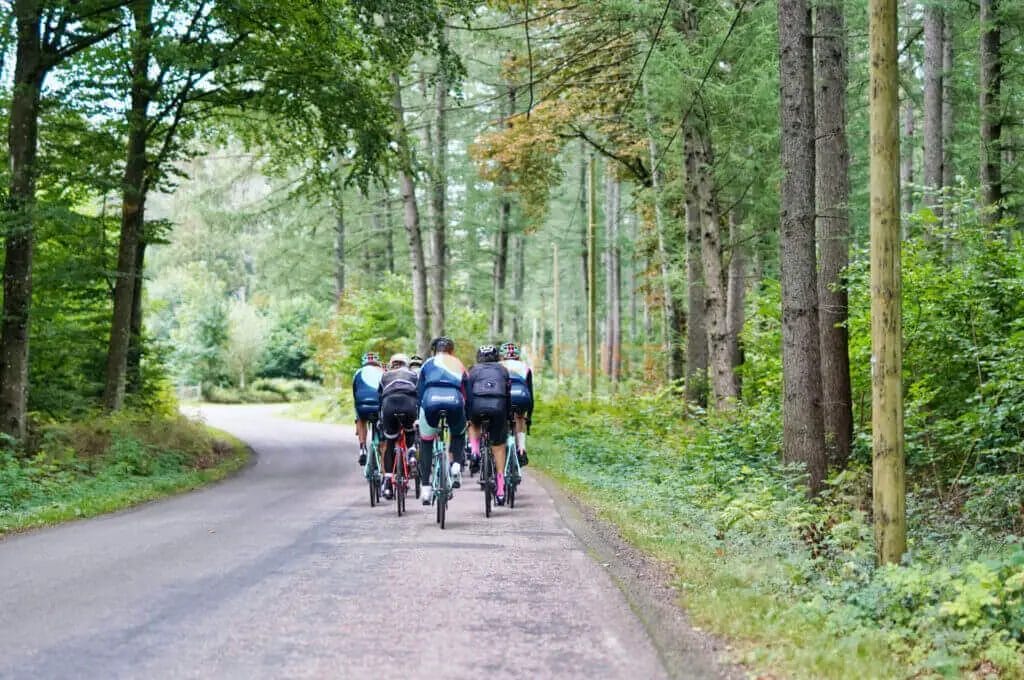Last Updated on March 23, 2024 by Vinson Lozano
A gravel race is no ordinary cycling competition. This form of race involves tackling diverse terrains, including dirt roads, forest trails, and sometimes pavement. Training for a gravel race is also unique, as it requires building both physical strength and mental resilience.

What is a Gravel Race?

Gravel Racing refers to bike races that take place primarily on unpaved roads. Sometimes overshadowed by road and mountain biking, gravel races are quickly gaining popularity due to their blend of the two.
The key lies in not only the physical preparation but also in the chosen bike’s setup. You need a reliable bike that can comfortably handle mixed terrains, combining the lightness of road bikes and the ruggedness of mountain bikes.
Benefits of Training for a Gravel Race

Physical Fitness: Training for a gravel race is a fantastic full-body workout. It targets virtually every muscle group, especially core muscles, which are crucial for maintaining balance and bike control on uneven gravel roads.
Mental Toughness: Gravel races aren’t just physically demanding; they are a test of mental strength as well. The varying terrains and the unpredictable conditions can be challenging, but with proper training, you can develop the mental grit required to combat both.
Exploration: With routes often set in beautiful, off-beat tracks, training for gravel races allows you to explore places you wouldn’t likely visit otherwise. As the saying goes, the journey is often as rewarding as the race outcome.
Improves Cycling Skills: Mastering the art of gravel racing enhances bike maneuvering skills. This could dramatically enhance road or mountain biking skills.
In essence, training for a gravel race helps you prepare for the unpredictable, enhances your physical performance, mental toughness, and satiates the inner explorer in you. So gear up and embrace the grind; the gravel roads await!
Choosing the right bike
As a gravel racing enthusiast, one imperative you must abide by is choosing the right bike. Picking an ideal bike not only enhances your performance but also significantly impacts your overall experience during the race.
Types of Bikes for Gravel Racing
Gravel racing bikes vary, and the most suitable option highly depends on the type of race and the rider’s preference. Below are the most common types:
- Gravel Bikes: These types of bikes are most suited for gravel races due to their design and versatility. They feature wider tire clearance and a more relaxed geometry for stability and comfort on rough terrains.
- Cyclocross BikesCyclocross Bikes: While originally designed for cyclocross races, these bikes can also offer a good performance in gravel races, especially for short and fast races. They are durable, lightweight, and have wide tire clearance.
- Mountain Bikes: Particularly for races with more technical and challenging terrains, mountain bikes can come in handy. They have robust construction, wider tires, and excellent suspension systems.
Factors to Consider When Choosing a Gravel Bike

Here are some factors to consider when choosing a gravel bike for racing:
- Tire Clearance: Wide tire clearance enhances stability and comfort. This feature is beneficial, particularly for long and demanding gravel races.
- Comfort: Check features such as saddle design, bike geometry, and handlebar setup that contribute to your comfort during the race.
- Durability: The bike should be able to withstand the rough and harsh conditions of gravel trails. Considering the frame material is crucial. Options include steel, aluminum, carbon fiber, and titanium, with each material offering different benefits and drawbacks.
Remember, the key to an enjoyable and successful gravel race largely depends on the prowess of your bike. Choose wisely!
Building Endurance
In the world of gravel racing, endurance is king. It’s not just about how fast you can bike but how long you can sustain that pace. Thus, building endurance is crucial when training for a gravel race.
Importance of Endurance Training for Gravel Racing
Endurance Training is key in preparing your body for the long, challenging miles of a gravel race. It trains your cardiovascular system to work efficiently, allowing your heart and lungs to deliver oxygen to your muscles more effectively.
This training also enables your muscles to withstand fatigue, making you capable of pushing harder and longer during the race. Moreover, endurance training helps in improving stamina and mental resilience – two critical elements in gravel racing.
Effective Endurance Training Strategies
1. Long, Slow Rides: Start by gradually increasing the distance of your rides at a comfortable pace. Over time, this builds your aerobic base, laying the foundation for more intense workouts later.
2. Interval Training: This involves bouts of high-intensity efforts followed by periods of rest or lower-intensity exercise. Example: Cycle at maximum effort for 1 minute, then rest for 2 minutes. Repeat.
3. Tempo Rides: These are moderately intense workouts maintaining a steady pace for a given duration. They help enhance your lactate threshold – the intensity at which your body can clear lactate from your blood as quickly as it is produced.
4. Hill Repeats: Riding up a hill repeatedly at a high intensity makes your body adapt to hard efforts and builds muscle strength.
5. Cross-Training: Activities like running, swimming, or strength training can supplement your cycling workouts and provide a well-rounded fitness base.
By incorporating these strategies in your training plan, you can effectively build endurance for your next gravel race. Remember, consistency is vital – improvement comes with time. Don’t rush the process; listen to your body and adjust your training as needed. Happy training!
Strength Training

For those seeking to participate in gravel racing, a cycling discipline growing in popularity, strength training stands as a crucial component of preparation. Upholding a solid foundation of strength can radically augment cycling performance, whilst also preventing injuries.
Role of Strength Training in Gravel Racing
1. Enhancing Cycle Power: Strength training is integral to improve muscle power, which in turn foster the ability to sustain or increase speed on the bike. Additional strength aids to perform efficiently in countering challenging terrains encountered in gravel races.
2. Preventing Injuries: A well-rounded strength training program can significantly reduce the risk of injuries. Reinforcing muscles, joints, and ligaments enables the body to endure long, grueling rides and help recover more expeditiously after races.
Key Exercises for Gravel Racers
Several exercises are specifically beneficial for gravel racers:
1. Squats: This exercise is vital because it works on the quadriceps, hamstrings, and glutes that are engaged while pedaling.
2. Lunges: They are similar to squats but target each leg individually, promoting balance and coordination necessary for cycling.
3. Deadlifts: They work on the lower back and glutes, crucial to maintain a forward-leaning cycling posture.
4. Core exercises: A strong core is fundamental for balance on a gravel bike. Planks or Russian twists can strengthen the core muscles.
5. Upper Body exercises: Cycling, especially gravel racing, is not just about leg power. Exercises such as push-ups or pull-ups can strengthen the upper body, enhancing overall balance and bike control.
Incorporating these exercises into a routine training regimen can bring substantial benefits to aspiring gravel racers. The key is consistency and gradual increase in intensity, to ensure steady progress without risking injuries. Remember, always consult a fitness professional or coach before embarking on a new training program.
Interval Training

Effective interval training can make a significant difference to your performance in a gravel race. Interval training, a type of training that involves periods of intense workouts alternated with recovery periods, can improve your speed, endurance, and power – all critical elements needed to excel in gravel racing.
Benefits of Interval Training for Gravel Racing
1. Increases Endurance: Interval training helps improve your cardiovascular system, thereby increasing your endurance over longer races.
2. Enhances Speed: The high-intensity periods of an interval training session improve your speed, allowing you to cover more ground in a shorter time during the race.
3. Builds Power: Interval workouts also bolster your power, giving you the push needed for challenging climbs characteristic of most gravel races.
Sample Interval Training Workouts
1. High Intensity Intervals: After a 10-minute warm-up, push yourself at a high-intensity pace for 30 seconds, followed by a 30-second recovery pace. Repeat this cycle for 15-20 minutes, then cool down for 5-10 minutes.
2. Power Intervals: Warm-up for about 10 minutes. Then, ride at your maximum power for three minutes, followed by a two-minute recovery period. Repeat the cycle five times and then cool down.
3. Endurance Intervals: Try a 20-minute interval at a fast but sustainable pace after a 10-minute warm-up. Rest for five minutes, then repeat the interval. Cool down afterwards.
Remember, the key to interval training is the quality rather than the quantity of the workout. Each workout should be structured to match your current fitness level and the demands of the gravel race for which you are preparing.
As you progress through your training, the duration, intensity and recovery periods of your intervals can be adjusted to continually challenge your body and optimize performance.
Nutrition and Hydration

When preparing for a gravel race, the importance of a balanced diet and good hydration cannot be overstated. These components weigh into your performance during the race and how quickly you recover afterward. Let’s delve into the role of nutrition and hydration in gravel racing.
Importance of Proper Nutrition and Hydration in Gravel Racing
Proper nutrition is essential to fuel your body during the training process. A balanced diet that includes carbohydrates, proteins, and fats will provide the energy needed for endurance and strength. To replenish lost electrolytes during your workout sessions, you need to plan your fluid intake strategically.
As well, good hydration plays an essential role in maintaining body functions and optimizing performance. Dehydration can lead to muscle cramps, fatigue, and a reduced capacity to regulate body temperature, thus affecting racing performance.
Tips for Fueling and Hydrating During Training and Races
1. Incorporate Carbohydrates: Carbohydrates are your body’s preferred source of energy, and including them in your diet can ensure you have the energy needed to perform at your best level. Foods like oatmeal, pasta, bananas, and potatoes are excellent sources of carbohydrates.
2. Stay Hydrated: It’s essential to hydrate before, during, and after the race. Water is the most straightforward hydration option, but you may also want to consider sports drinks or beverages containing electrolytes if you’ll be racing for a considerable period.
3. Eat a Balanced Pre-Race Meal: Ensuring you have a meal that’s rich in carbohydrates and proteins will help to sustain energy and muscle repair during the race.
Choosing the right fuel for your body can make a huge difference in your overall race experience. Remember, every person is unique, so what works best for one person might not be best for another. It’s crucial to try various options during your training to ascertain what works best for you.
Mental Preparation

Before we dive into physical workout regimens, we need to give due attention to an equally important aspect of preparation: the mental game.
The Role of Mental Preparedness in Gravel Racing
Mental preparedness plays a crucial role in gravel racing. Unlike traditional road racing, gravel races often feature diversified routes that vary from flat to hilly terrains and different weather conditions can drastically change your racing experience. These unpredictable elements can test your mental fortitude at every pedal stroke.
Successful gravel racers are not just physically fit; they are also mentally prepared to adapt to the changing conditions. Being quick and smart in making decisions such as choosing the right path or knowing when to push or conserve energy, significantly contributes to your performance and overall racing experience.
Techniques for Developing Mental Toughness
Meditation and Visualization: Consider training your mind through meditation and visualization. Just as you map out your race course, envision yourself completing the race – anticipate the tough climbs, tricky descents, and the triumphant finish.
Set Realistic Goals: Consistent motivation and a sense of accomplishment breed mental toughness. Divide your training into smaller, manageable goals that can be achieved in weeks or months. Every small victory will fuel your self-confidence, giving you the extra mental edge you need on race day.
Positive Affirmations: Develop a mantra that resonates positivity and self-belief. Repeating these affirmations during your training, and eventually the race, can help maintain your mental focus even during the toughest parts of the race.
Mental Recovery: Just as physical recovery is important, so is mental recovery. Allow yourself rest days to let your mind rejuvenate and reset.
Remember, your mind is a powerful tool in any form of racing, including gravel racing. Training it alongside your body will make you a well-rounded competitor, ready to take on the many challenges that gravel racing presents.
Recovery and Rest
Preparing for a gravel race doesn’t only involve strenuous training rides and boosting your stamina, but it also demands ample time for recovery and rest.
The Importance of Recovery in Gravel Racing
Recovery is an essential component of any training program. While in the recovery phase, your muscles repair, adapt, and strengthen in response to the stress of exercise. This process helps to reduce the potential for overuse injuries, increase endurance level, and better prepare you for the next training cycle.
Gravel racing is a physically demanding sporting event that involves variable terrain and requires a tremendous amount of strength and stamina. Therefore, a well-structured recovery period in your training program is required to maximise performance and prevent injuries.
Strategies for Optimal Recovery and Rest Days
1. Sleep: Sleep is critical for muscle recovery. Aim for at least 7-9 hours of quality sleep each night.
2. Nutrition: Eat a balanced diet rich in complex carbohydrates, lean proteins, and healthy fats to fuel your recovery.
3. Hydration: Remain well-hydrated during all stages – pre-training, during, and post-training – to help replace fluids and electrolytes lost during the strenuous exercise.
4. Active Recovery: This might include low-intensity cycling or walking on your rest days to help reduce muscle stiffness and enhance circulation.
5. Rest Days: Incorporate complete rest days in your training schedule to fully recover your muscles and central nervous system.
Considering recovery and rest as a critical part of your training plan for the gravel race will optimise your performance, prevent injuries and keep your motivation high. Remember – ‘Rest is part of the plan, not the absence of it’.
Here’s an indicative plan for recovery and rest during gravel race training:
| Day | Strategy |
|---|---|
| Monday | Intensive training |
| Tuesday | Active Recovery |
| Wednesday | Intensive training |
| Thursday | Complete Rest |
| Friday | Moderate training |
| Saturday | Intensive training |
| Sunday | Active Recovery |
This strategic and balanced mix of training, active recovery, and rest days can help you effectively prepare for your next gravel race.
Conclusion
Training for a gravel race can feel like a daunting task. However, with the right plan and commitment, it is definitely an achievable goal. Here, we provide some key takeaways and concluding thoughts on preparing for a gravel race.
Key Takeaways for Training for a Gravel Race
1. Build Endurance: Improving your stamina is paramount for a gravel race. Long rides using a mix of terrains are an effective way of gaining the necessary endurance. Endurance training can enhance VO2 max or maximal oxygen consumption, improving the body’s ability to utilize oxygen, a key aspect in long-distance cycling.
2. Strength Training: Besides cycling, ensuring you incorporate strength training into your regimen is essential. It helps in preventing injuries, improving power, and ensuring overall body strength.
3. Terrain Familiarity: Familiarize yourself with different types of terrains. This can increase your confidence and technical skill on race day.
4. Nutrition and Hydration: Both are key aspects of your training program. A balanced diet with an apt mix of carbohydrates, proteins, and healthy fats equips the body with the required fuel. Simultaneously, maintaining proper hydration helps in better performance and recovery.
5. Rest and Recovery: Training for a gravel race isn’t just about physical exertion. It’s crucial to give your body enough time to rest, heal, and adapt to the increased physical demands.
Final Thoughts and Encouragement
When it comes to training for a gravel race, remember, consistency is key. Don’t underestimate the importance of rest days and don’t rush the process. Listen to your body and give it the right resources to perform at its best.
Set realistic expectations and goals, stay motivated, and above all, enjoy the process. And most importantly, believe in yourself. With determination and proper planning, completing a gravel race isn’t just a dream but a milestone awaiting achievement. Good luck!


